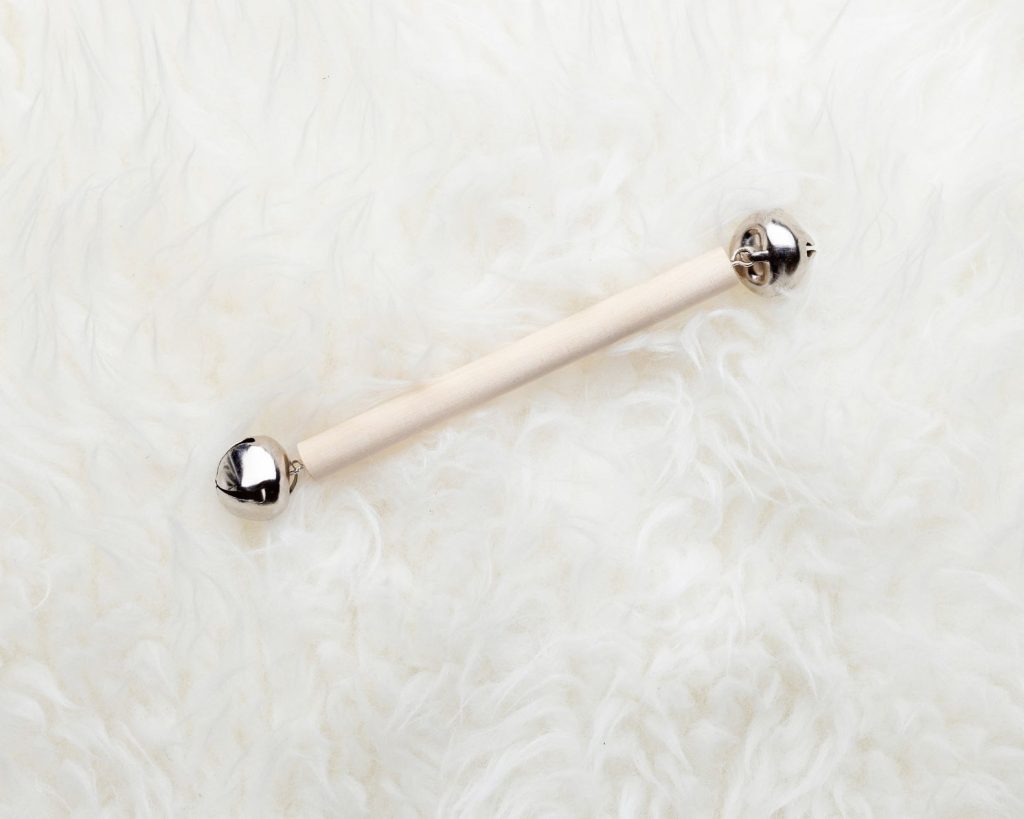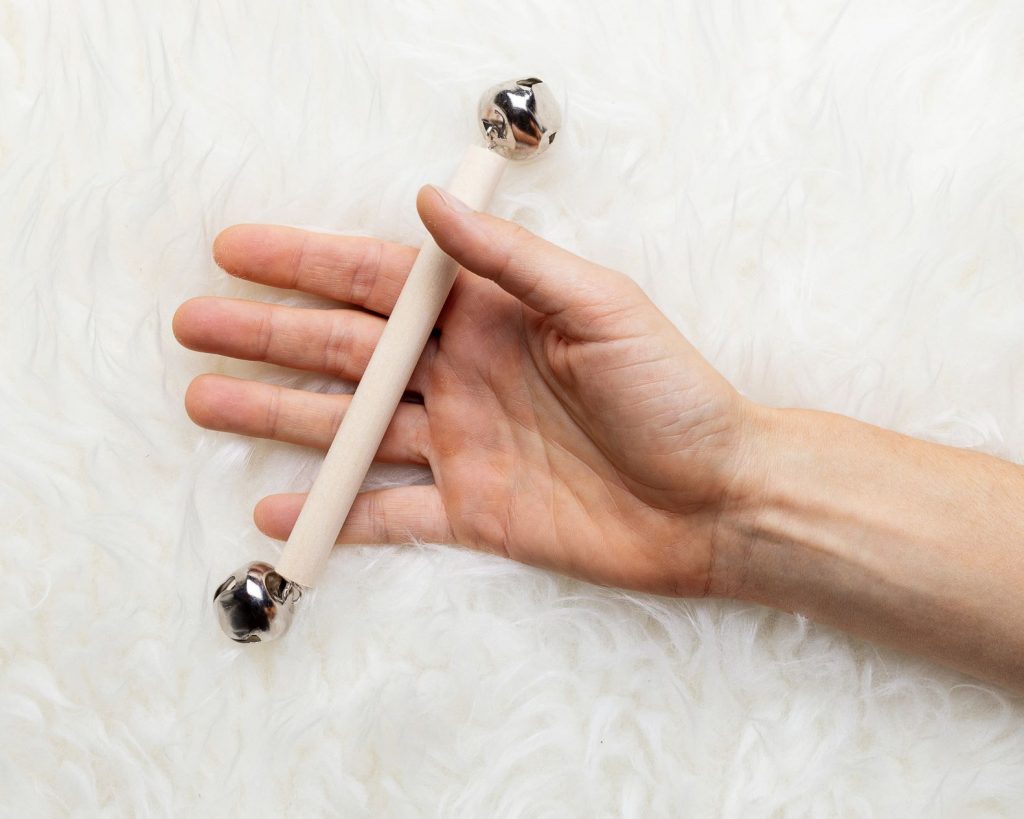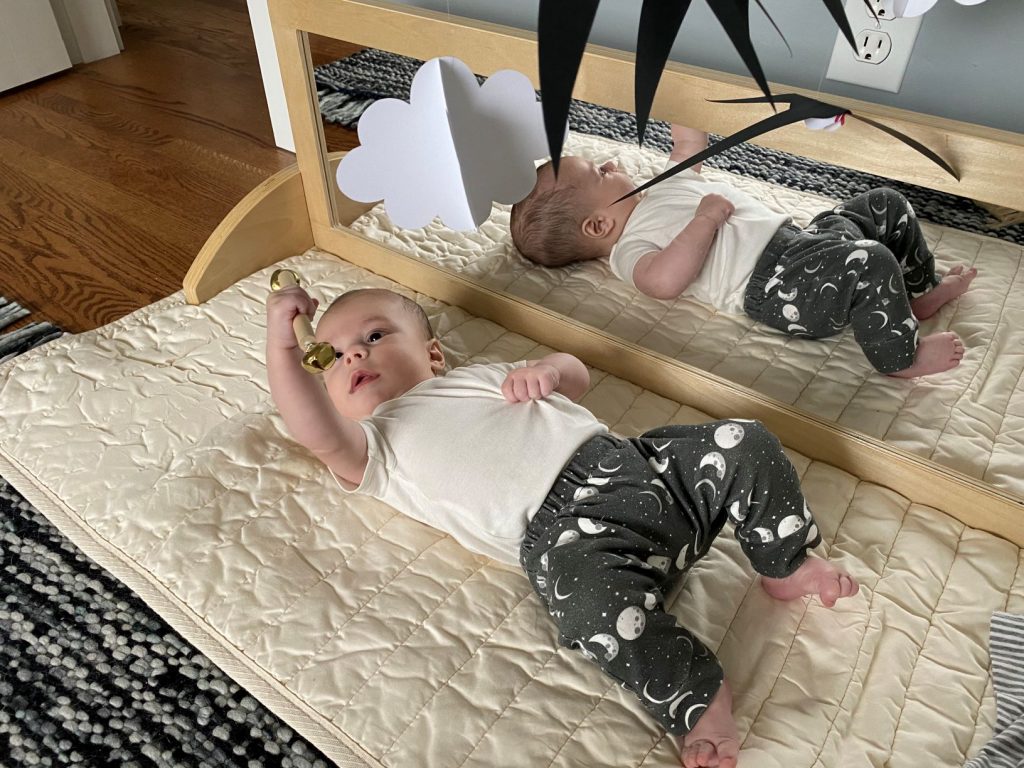So far, I have written posts about the Visual Mobile series and we have also looked at the Tactile Mobiles. These all belong to the category of hanging baby mobiles. Which is all great and fun, but we don’t spend all our time at home! What should we do when we’re on the move? Which we are, like, all the time! Going grocery shopping, to the post office, to pick up the older child, to visit friends… We can’t just carry a mobile holder with us! Luckily, there’s a solution! Ladies and Gentlemen, we are officially saved! The Montessori Bell Rattle is small, so fits into your baby’s hands, but it makes a noise so it’s easy to find when it falls out of the buggy by accident. Small but important detail, right? (wink) Let’s take a closer look.
THE FIRST MONTESSORI ‘TOY’
The Montessori Bell rattle is the first object we can actually give to our baby to hold therefore it is often called the first Montessori ‘toy’. I put the word ‘toy’ in brackets as ‘Montessorians’ don’t technically consider it as one. Looks like one, ‘talks’ like one, but instead of entertainment, it makes babies “work”. Every Montessori material has a specific aim of how to help your baby’s development and at what age it has to be used. We can introduce the Bell Rattle around 2.5-3 months (every baby develops at a different pace).
Why have we been waiting for so long? In the first couple of months babies’ focus their development on their sense of sight, which is the time of the Visual Mobiles. Around 2.5-3 months you’ll notice that they start reaching, batting, grabbing and pulling, this is when we introduce the Tactile Mobiles. Their ‘job’ is to help making little ones’ movements from involuntary to voluntary, giving them more control over their body and work those fine and gross motor skills. When those little muscles are ready to grab and hold using their tiny hands, that’s when they are physically ready for the Montessori Bell Rattle.
WHAT DOES IT LOOK LIKE?
Similar to other Montessori materials, the Bell Rattle is also very simple. It has a short, thin dowel, so it fits perfectly into baby hands. The wood is long and smooth, easy to take when it falls. The rattle has two bells which are attached to it by eye hooks. These bells are usually silver but can be any colour. What is important is that:
- they make a soft sound so as not to scare the baby
- they are shiny!
And that’s it! You’ve got a Bell Rattle!

SO WHY IS THE MONTESSORI BELL RATTLE SO ATTRACTIVE FOR YOUR BABY?
The secret of this Rattle is that it has two shiny bells! They draw the eyes of everybody around it. And just wait until your baby makes an involuntary movement to hear them jingle! Thanks to them being so attractive, s/he can clearly see where the sound is coming from. This will encourage him/her to connect the sound and the movement and to explore the relationship between cause and effect. Soon this will be his/her favourite thing in the house.
Being able to grasp a desired object has a huge impact on a baby’s understanding of the world. Those babies who use their hands a lot to explore a variety of items have a greater understanding of their place in their surroundings. This means that they feel more confident in themselves and have greater motivation to discover.

WHAT ARE THE SCIENTIFIC BENEFITS OF THE BELL RATTLE?
- It strengthens hand muscles
- It assists in making controlled, voluntary movements in the hands
- Stimulates fine and gross motor skills
- Provides new sensory experiences
- Allows for exploration of the relationship between cause and effect
- Encourages auditory development
- Make purposeful movements and planned actions
- Develop hand-eye coordination
- Open their curiosity towards their surroundings
- They transfer an object from one hand to another
- Passing an object encourages passing the middle line of the body…
- Which in turn stimulates both sides of the brain
- Being able to use it to its purpose raises self-esteem
PRESENTATION
Make sure that your baby is fully awake, fed, alert, and ready to work before you introduce this material. There are two suggested ways to present it.
- Shake the bell until your baby’s eyes find and watch the Rattle. Shake it again to make sure that s/he understands that that’s where the sound is coming from.
The next day, or whenever you feel like your little one is ready for the next step, show it again. Then, while your baby is watching, move it to one side of your baby’s head. Make sure s/he knows where the sound is coming
from. Then slowly move it to the other side.
The next step is when you move the bell out of your little one’s sight. Move it to one side of the head and wait until your baby turns and sees it. Move it to the other side. Above the head. Find other places to move it to. - Present it by not presenting it. Meaning, you just hand it to your baby and see what s/he’s going to do with it. This allows him/her to explore it at his/her pleasure. If you see that s/he gets agitated, it’s probably because s/he finds it too overwhelming. In this case, do the steps in the previous presentation.
TIPS AND TRICKS
The first time your baby holds it s/he will probably immediately drop it. It’s ok, as the hand muscles have to get strong enough to be able to hold an object for an extended period of time. S/he also needs to work on fine and gross motor skills and making uncontrolled movements more controlled to be able to do it. Give it time and observe how s/he improves and tackles this personal challenge little by little, day by day.
You can check which hand your baby prefers by offering it first to the left, then to the right, then in the centre. Some babies seem to have quite strong preferences. This, however, is not an indication whether your little one’s going to be left or right-handed.
If you have a mirror on the floor, make sure that your baby can see him/herself clearly when working with the bell rattle. Read about a Montessori baby movement area in this post.

IMPORANT TO KNOW
Please note that the Bell Rattle is not suitable for babies who are in the phase of mouthing. When you see your little one trying to put the bell in the mouth, gently take it away. You might have to put it out of sight for a few months. Later you can use it again as a musical instrument, until the toddler years and over.
Check that the bells are firmly in place and smooth the dowel with your hand each time before giving it to your baby. Always monitor when in use.
FINAL THOUGHTS
The Montessori Bell Rattle is a simple but very versatile sensory material. The quiet jingle of the bells you hear when you shake it is just enough to grab your baby’s attention without overwhelming them. It’s just the perfect object to learn about cause and effect! It also assists in training the natural grasping reflex while developing their grip, strength, motor skills and body control. It’s another classic Montessori object that will grow with your baby, who’ll always be tempted to explore and manipulate it in new ways.
It’s such an easy material to DIY! You can buy all the resources for the DIY Montessori Bell Rattle and other DIY Montessori products for babies in my Shop.
Click here to read more about how the Montessori Visual Mobiles, the Montessori Tactile Mobiles or the Sensory Baby Toys help your baby’s development.
How did your baby react to this material? Please share your photos on my Instagram site. #montessoriedited, @montessoriedited
